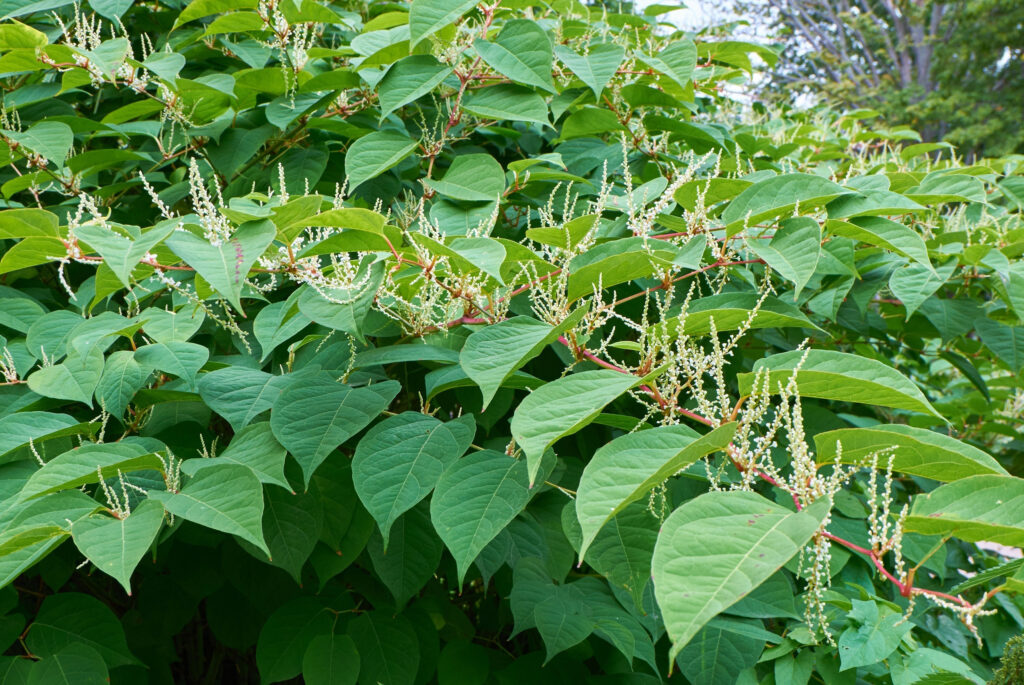You’ve probably heard of Japanese Knotweed and may be aware of some horror stories regarding this invasive plant.
When it comes to property, Japanese Knotweed is a menace – it’s difficult to identify, difficult to eradicate and can cause huge damage to your home if left untreated. Here, we’ll explain what Japanese Knotweed is, how you can spot it and the steps you’ll need to take to get rid of it – especially if you’re thinking of selling your home.
What is Japanese Knotweed and how did it get to the UK?
Japanese Knotweed, as you might have guessed from the name, is not a native plant to the UK.
It was brought in from Japan, Korea and China in the 19th century and has spread rapidly across the UK since then.
It grows most aggressively around wet areas such as canals and lakes but has also taken hold around railway embankment – and people’s gardens.
Once it takes hold, it spreads rapidly – dominating other plant species and affecting wildlife, as well as causing damage to property.
What does Japanese Knotweed look like?
The fact that many homeowners are unable to identify Japanese Knotweed gives it an even better chance of spreading.
Japanese Knotweed buds sprout in spring and are red in colour, before red shoots appear and grow into stems which are often mistaken for bamboo.
The stems are green with purple spots and Japanese Knotweed leaves turn from a yellow/brown colour in spring to rich green in summer.
The shovel-shaped leaves can grow around 14cm in length and are followed by small white flowers in the autumn months.
Identifying Japanese Knotweed
For the uninitiated, Japanese Knotweed can look like a whole host of other plants – and that’s what makes it so potentially damaging.
Being able to identify Japanese Knotweed early is one of the keys to eradicating it before it takes hold.
The plants often mistaken for Japanese Knotweed include:
• Lilac
• Bindweed
• Bamboo
• Russian Vine
However, each of these plants does have distinctive differences to Japanese Knotweed, so if you’re unsure, call in an expert to correctly identify any plants or weeds of concern.
How does Japanese Knotweed spread?
Japanese Knotweed grows quickly, which is one of the factors that makes it so hard to wipe out.
It grows by creating underground stems called rhizomes and a new plant can grow within 10 days from a piece of rhizome no bigger than your fingernail. It can also grow back from stems that are cut but left to immerse in soil or water – proving beyond doubt that simply cutting back Japanese Knotweed and hoping it will go away is fruitless.
How common is Japanese Knotweed?
It’s estimated that as many as 5% of homes in the UK are affected by Japanese Knotweed, which given there are an estimated 29 million homes in the country, is a considerable problem.
Research from comparison site HaMuch.com estimates that around 1.45 million homes in the UK are affected by Japanese Knotweed.
And not only that – the analysis suggests that a huge £32.12 billion has already been knocked off property prices due to infestations of the plant.
That’s the equivalent of just over £23,000 off the average UK property’s value.
What damage does Japanese Knotweed cause, and can it grow through concrete?
One of the myths surrounding Japanese Knotweed is that it can grow through concrete.
This is not true, but it can grow through cracks in concrete and, if built on, it’s also able to find its way out into the open by growing horizontally.
When it comes to property damage caused by Japanese Knotweed, many of the horror stories are true.
It can work its way through cavity walls, drains and through cracks in asphalt, meaning the external structure of your home could be severely affected if you have an infestation.
Underground damage
Japanese Knotweed is a thirsty plant during the growing season, so it can often be found snaking through cracks or joints in pipework where it can eventually expand and break the pipe.
Cracking hard surfaces
The most common damage caused by Japanese Knotweed is to asphalt on driveways or slabs on patios.
When driveways or patios are laid on top of an underground infestation, Japanese Knotweed has no problems growing up through cracks, before expanding and causing large amounts of damage.
Cavity walls
Japanese Knotweed can grow up through cavity walls and air blocks, before pushing through and forcing the two walls apart.
Why does Japanese Knotweed spread so quickly?
Japanese Knotweed can grow up to 10cm a day in summer and the rate it spreads at is often boosted by homeowners attempting to remove the plant themselves. Its underground network of stems means it is extremely difficult to remove completely, even by professionals, and a new plant can grow from a piece of stem just a few millimetres in length.
It’s also extremely resilient, meaning a dried-up, seemingly dead piece of Japanese Knotweed can regrow if it comes into contact with soil or water.
How to treat Japanese Knotweed – and what you definitely shouldn’t do
Many homeowners, who often just think Japanese Knotweed is a fast-growing plant, will simply cut it back or take a garden strimmer to it.
Once the cut stems come into contact with soil or water, they can form a new growth within 10 days.
Others attempt to remove it with weed killer or chemical sprays and once it appears dead, believe the problem has gone away. This is often not the case as Japanese Knotweed underground stems can sit dormant for up to 20 years, growing again at any time conditions are right.
Killing Japanese Knotweed
Essentially, the only way to remove Japanese Knotweed from your property for good is to use a professional.
But beware: It’s not a quick process and can be costly.
Consistent use of specialist weed killer is the method most commonly used for removing Japanese Knotweed, but often treatment will need to be carried out over a number of years.
Another option is to dig up the plant and its underground stems, but it must then be disposed of according to Environment Agency guidelines.
Severe infestations of Japanese Knotweed can see treatment costs spiral, so it pays to seek advice from the Environment Agency if you believe you may have the plant on your property.
Japanese Knotweed treatment costs
Unfortunately, Japanese Knotweed treatment can cost anywhere between £2,000 and even as much as hundreds of thousands of pounds for vast areas. However, a bad Japanese Knotweed infestation could also mean:
• Your home is worth between 5% and 15% less
• Buyers may not be able to get a mortgage to purchase your property
After factoring in those scenarios, homeowners are usually left with no option other than to bring in a professional treatment company.
Japanese Knotweed treatment costs vary depending on the professional used to deal with the problem, the seriousness of the infestation and the type of treatment required. Japanese Knotweed treatments include:
• Herbicide treatments
• A full excavation
How long do Japanese Knotweed treatments take?
Effectively treating Japanese Knotweed infestations can take years.
Because the plant is so effective at re-growing, herbicide treatments need to take place usually over three to five years in order to fully eradicate the problem. A full excavation and safe disposal of the plant can remove the infestation immediately, but this is more costly than chemical-based treatments.
Fines for dumping Japanese Knotweed
It’s not an offence to have Japanese Knotweed growing on your property.
But you could be facing a heavy fine or even a prison sentence if you cause the spread of the plant in the wild by dumping contaminated soil or remnants of the plant.
You could also face legal action from neighbours if you don’t take steps to control the plant and it infiltrates their properties.
Can I still sell my home if I have Japanese Knotweed?
You can still sell your home if you have Japanese Knotweed.
But buyers are also entitled to know if a property is affected and failing to disclose information like this could see you facing legal action if you try to sell your home without disclosing an infestation.
Who to contact if you suspect Japanese Knotweed at your property
A host of companies offer professional surveys to establish Japanese Knotweed growth and from that, a treatment plan can be established. Before agreeing to a treatment plan, be sure that the specialist offers a guarantee of at least five years should the plant return and require further treatment.
Further reading…
Gardens can be really great selling points if you’re putting your home on the market – our guide explains how you can add value to your property through its garden.




